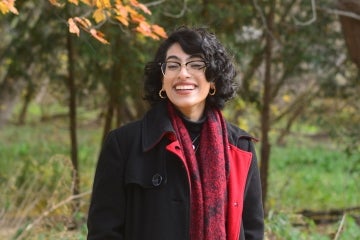Making the case for partnerships with cities: Universities Canada at U of T
Published: April 28, 2016
“I don’t think I have a city committee without professors on it,” Dave Jaworsky, mayor of Waterloo, Ontario, told the mayors and university presidents gathered at the University of Toronto’s Simcoe Hall.
“I think I’m very fortunate.”
Jaworsky was speaking at Partnerships for a Shared Agenda, the annual meeting of Universities Canada, hosted this year by U of T April 26-27.
Throughout the conference, participants shared their conviction that universities are more directly relevant to urban planning and urban living than ever before.
“It is hugely exciting,” President Meric Gertler said, “to see the growing awareness among policy makers on the municipal, provincial and federal levels, that universities are key assets in generating, attracting, and retaining the talented people we need to create and share knowledge and to drive innovation and prosperity.”
The importance of the role of students was a recurring theme. Ramona Lumpkin, president of Mount Saint Vincent University, said Halifax views its universities as key to population growth – and the mayor’s office organizes an annual reception for international students.
“The city has as much to gain as we do by making sure those students feel welcome and see our city as an attractive place to stay and apply their talents and skills,” Lumpkin said.
Peter Stoicheff, appointed president of the University of Saskatchewan last October, said the presence of a pro bono law clinic and a health provider including dental services connects students directly with the downtown community.
“Universities contain a lot of expertise that is of use to cities,” Stoicheff said, adding the U of Saskatchewan urban planning program has strong links with the city planning office.
A panel discussion seeking “intersections for enhanced university-municipal engagement” found many relevant instances. Matt Brown, mayor of London, Ontario cited the Syrian refugee crisis as an issue that brought many sectors, including education, together in recent months.
Panellist Eric Miller, a U of T engineering professor and the director of the University of Toronto Transportation Research Institute, asked whether the relationships that medical schools have long cultivated with hospitals can serve as a template for university-civic cooperation.
“We have teaching hospitals,” Miller said. “Can we have teaching municipalities?”
Fellow panellist Shauna Sylvester is executive director of Simon Fraser University Public Square, an initiative that connects that university to the community. Sylvester estimated she spends at least half her time on city issues.
“Whether it’s working on parking with the district of North Vancouver, transportation planning in Victoria, safety in Surrey, district energy in Calgary or geothermal in Toronto, it’s quite astounding,” Sylvester said.
All agreed the environment is an important example of an issue that demands input from universities and cities alike.
“Almost 50 per cent of the greenhouse gas emissions in this country are under the direct or indirect control of municipal government,” said Brock Carlton, CEO of the Federation of Canadian Municipalities. “This is a big footprint. But cities can’t do it alone. They need collaborators and partners. And that’s what brings us to this conversation.”
Jaworsky pointed to NSERC-supported research by the U of Waterloo into the reduction of idling by City of Waterloo trucks. “This will pay environmental benefits, for sure,” he said, “but also economic benefits.”
Universities also have a crucial role to play in Indigenous issues, speakers agreed.
Annette Trimbee, the president of the University of Winnipeg and a former deputy minister in Alberta, said she moved back to her home town because the university had become an inclusive place where she felt she could make a difference.
“We are downtown but not in prime real estate,” Trimbee said of the university campus. “We’re in an economically deprived area that is culturally very rich. Unemployment rates are high, graduation rates are low.
“The status conversation in Winnipeg isn’t ‘How much do you make?’ or “What do you do in your down time? The status conversation is, “Whom do you give to, how do you spend your volunteer time?”
Trimbee said she believes that Winnipeg, with its large population of Indigenous youth, is “at the epicentre of an Indigenous comeback in this country.”
Stoicheff said closing the educational gap for Indigenous people is inevitably a joint project of cities and universities, despite the fixed nature of federal jurisdiction in this area.
“Not having that relationship would be damaging to the overall federal attempt to do exactly that.”
The conference also featured keynote speeches by Mississauga Mayor Bonnie Crombie; David McKay, president and CEO of the Royal Bank; and Bill Thomas, CEO of the KPMG audit and tax firm. Moderators included Carlton and National Post editor-in-chief Anne Marie Owens.
“I don’t think universities were ever actually ivory towers, but now they are active in communities every day,” Paul Davidson, president and CEO of Universities Canada, told U of T News.
“This session is a reflection of how universities have evolved over the last 20 years and how municipalities have evolved.”



